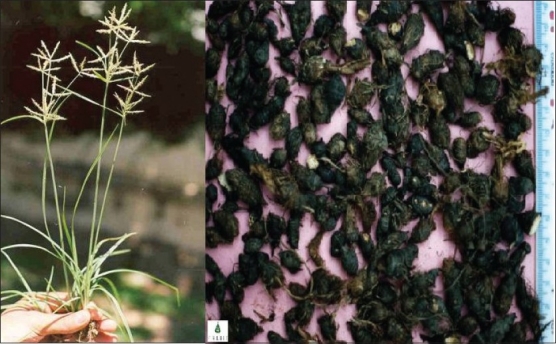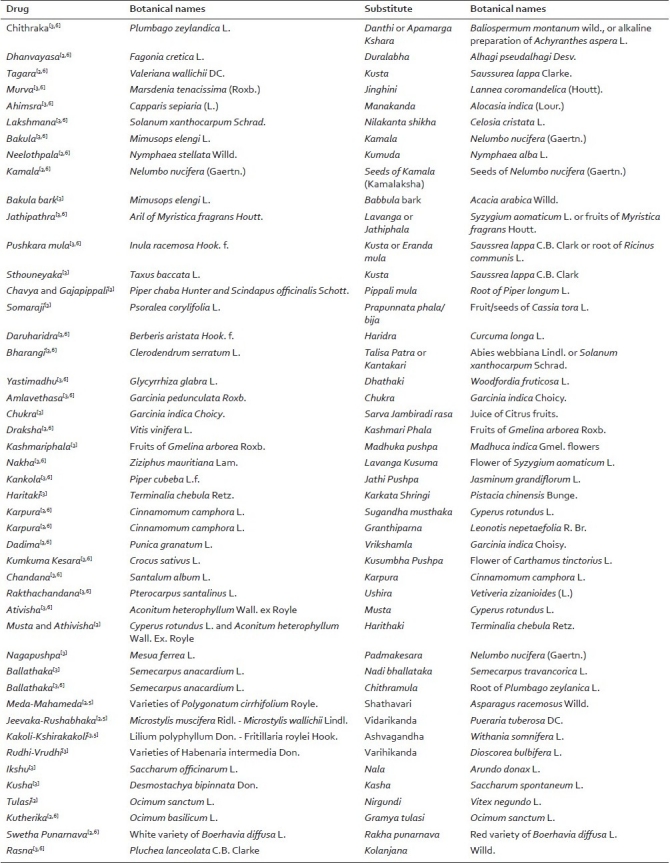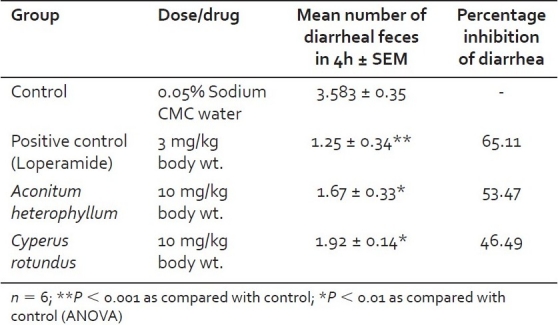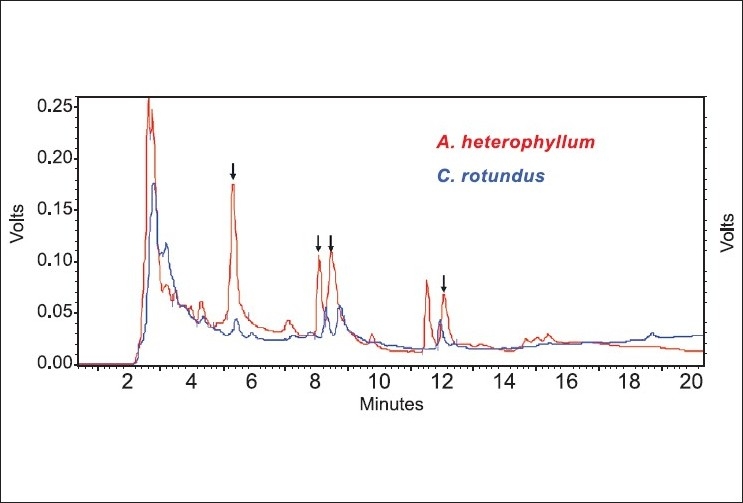Abstract
In the absence of a desired first choice medicinal herb, classical Ayurveda recommends use of a functionally similar substitute. Post 16th century Ayurvedic texts and lexicons give specific examples of possible substitutes. Here we report a preliminary study of one such Ayurvedic substitution pair: Musta (Cyperus rotundus L., Cyperaceae), a common weed, for the rare Himalayan species, Ativisha (Aconitum heterophyllum Wall. ex Royle; Ranunculaceae). The study's strategy was to use modern phytochemical and pharmacological methods to test the two herbs for biochemical and metabolic similarities and differences, and literary studies to compare their Ayurvedic properties, a novel trans-disciplinary approach. No previous scientific paper has compared the two herbs’ bioactivities or chemical profiles. Despite being taxonomically unrelated, the first choice, but relatively unavailable (Abhava) plant, A. heterophyllum, and its substitute (Pratinidhi) C. rotundus, are not only similar in Ayurvedic pharmacology (Dravyaguna) profile, but also in phytochemical and anti-diarrheal properties. These observations indicate that Ayurveda may attach more importance to pharmacological properties of raw drugs than to their botanical classification. Further research into the nature of raw drugs named could open up new areas of medicinal plant classification, linking chemistry and bioactivity. Understanding the logic behind the Ayurvedic concept of Abhava Pratinidhi Dravya (drug substitution) could lead to new methods of identifying legitimate drug alternatives, and help solve industry's problems of crude drug shortage.
Keywords: Abhava Pratinidhi Dravya, Ayurveda, anti-diarrheal, drug substitution
INTRODUCTION
Natural sources of medicinal plants are often unable to meet demand for popular herbal products. Populations of many species have limited distribution in their natural habitats, requiring conservation strategies for protection.[1] Unavailability of such medicinal plants has led to arbitrary substitution and adulteration in the raw drug market.[2] Even for some of the top-traded drugs such as Asoka (Saraca asoca Roxb.), there appear to be substitutes in today's market.[1] Ayurvedic texts from the 16th century and later, name several pairs of substitutes (Abhava Pratinidhi Dravya) for preferred plants, if unavailable (Abhava). For example, for Plumbago zeylandica L. (Chitraka) of the Plumbaginaceae family, they name Baliospermum montanum Willd[3] (Danthi), belonging to an entirely different family (Euphorbiaceae). While the concept of substitute use is mentioned as early as Charaka Samhita,[4] Bhavaprakasha Nighantu[5] and Bhaishajya Ratnavali[6] name plant pairs. Drug unavailability may have pertained to specific regions and not necessarily across the country.
Even a cursory glance at the list of Abhava Pratinidhi Dravya mentioned in classical Ayurveda texts excites scientific curiosity concerning the Ayurvedic principles behind selection of substitute drug. In this paper we report both Ayurvedic and preliminary phytochemical and pharmacological investigation of one pair of Abhava Pratinidhi Dravya viz., Ativisha (Aconitum heterophyllum Wall. ex Royle; Ranunculaceae) [Figure 1] and Musta (Cyperus rotundus L.; Cyperaceae) [Figure 2]. Aconitum heterophyllum is a high value (Rs. 4000/ kg), endangered Himalayan species with an estimated annual demand of over 400 MT.[1] It is traditionally used to cure fevers and diarrhea.[7–9] The suggested substitute, C. rotundus is a weed, used to treat similar conditions.[8,9]
Figure 1.

Ativisha (Aconitum heterophyllum Wall. Ex Royle.)
Figure 2.

Musta (Cyperus rotundus L.)
Topics like the one discussed here have evolved within the epistemological framework of Indian Systems of Medicine, whose principles, science and practice are different from those of Western biomedicine. Understanding them therefore requires trans-disciplinary approaches,[10] using scientific tools that can provide meaningful insights.
MATERIALS AND METHODS
A strategy was structured through brainstorming sessions involving expert Ayurvedic theoreticians and practitioners as well as modern scientists.
Listing Abhava Pratinidhi Dravya
A list of Abhava Pratinidhi Dravya was drawn up from the 16 to 19th century Ayurveda texts, Bhavaprakasha Nighantu,[5] Yogaratnakara[3] and Bhaishajya Ratnavali.[6] Due to striking dissimilarities in both taxonomy and trade value, A. heterophyllum and C. rotundus were selected for comparison at three different levels: Dravyaguna (Ayurvedic pharmacology), chemical profiles (using phytochemical screening and chromatographic fingerprinting) and pharmacology (comparative anti-diarrheal effects in mice models).
Plant material
Field samples of A. heterophyllum and C. rotundus were collected and authenticated by an authorized field botanist and Ayurvedic practitioner at FRLHT, Bangalore. Voucher specimens were deposited with the Herbarium and Raw Drug Repository (FRLHT, Bangalore, India). The Herbarium voucher specimen and Raw Drug accession numbers of A. heterophyllum were FRLH 46188 and L/06/11/10, while those of C. rotundus were FRLH 34337 and L/05/06/050, respectively.
Dravyaguna studies
Ayurvedic pharmacological parameters (Rasapanchaka) on Ativisha and Musta were compiled from Charaka Samhita,[4] Susruta Samhita,[11] Astanga Hridaya,[12] Yogaratnakara[3] and Bhaishajya Ratnavali,[6] and from lexicons like Bhavaprakasha,[5] Dhanvantari,[13] Raja[14] and Kaiyyadeva Nighantus.[15] Contemporary understanding was also considered from the works of authors like Sastry[8] and Sharma.[9] Information about similarities and differences based on Ayurvedic pharmacognosy, pharmacology (Dravyaguna) and Pancha Mahabhuta (five basic elements) dominance was analysed in terms of their Rasa (taste), Guna (properties), Virya (potency) and Vipaka (taste after digestion).[16]
Qualitative phytochemical evaluation
Methanolic extracts (5 g/25 mL) of the tubers of A. heterophyllum and C. rotundus were screened to identify the presence or absence of phytochemical groups.[17]
Chromatographic fingerprinting
Chemical fingerprints of A. heterophyllum and C. rotundus were compared under identical High Pressure Liquid Chromatography (HPLC) conditions. Two grams of air-dried A. heterophyllum and C. rotundus root were powdered and refluxed with methanol at 60°C for 1 h over a water bath. The extract was filtered and concentrated under reduced pressure in a rotary evaporator. Concentrated extract (30 mL) was used for HPLC analysis in a Shimadzu (Japan) system with a Rheodyne 20 μl injector, dual pump (LC-10ATVP), UV-Visible detector (SPD 10AVP) and a CLASS-VP6 software for separation and analysis. Stationary and mobile phases were Lichrocart C18 (250 × 4.6 mm; 5 μm particle size) column, and a gradient system of Water (Pump A) and Methanol (Pump B). Pump B starting concentration (10%) was raised to 100% in 45 min and maintained for a further 10 min. The column was equilibrated with initial solvent ratio for an hour and pumped at a rate of 1.0 mL/min for 55 min at 254 nm.
Pharmacological studies
Maximum Tolerated Dose (MTD) of dried methanolic crude extracts of A. heterophyllum for Swiss Albino mice was determined to be successive doses of 550 and 2000 mg/kg body weight in accordance with OECD 425 guidelines for tests of acute oral toxicity.[18] Animal experimentation was conducted at Al-Ameen College of Pharmacy, Bangalore. Drug performance was compared on anti-diarrheal activity, a clinical indication, for which Ativisha (Aconitum heterophyllum) is well known in Ayurveda. Approximately 10 mg/kg b.w. dried methanolic crude extracts of the two drugs were tested in a Castor oil-induced (0.1 mL/animal) diarrheal model on Swiss Albino mice.[19] Diarrhea severity was assessed by comparing total numbers of diarrheal feces excreted during recording periods for four groups of six mice. After 30 min, controls were fed 0.05% Sodium carboxy methyl cellulose suspended in distilled water, the second group received the reference drug Loperamide (3 mg/kg; p.o.). Test groups were orally fed 10 mg/kg b.w. of crude dried methanolic extracts (suspended in fresh 0.05% Sodium CMC) of A. heterophyllum and C. rotundus. Total number of diarrheal feces excreted over a 4-h period was scored. Standard deviations and P values were calculated using ANOVA.
RESULTS
The exercise of compilation of Abhava and Abhava Pratinidhi Dravya from 16th to 19th century Ayurveda texts drew a list of 46 pairs [Table 1], most of them being unrelated taxonomically. The logic of selection of substitutes, parts and details of usage were not mentioned in any of the referred texts.
Table 1.
List of Abhava Pratinidhi dravyas

An analysis of the texts summarized in Table 2 indicated that the Dravyaguna qualities of the two herbs i.e., Rasa (taste), Guna (properties), Vipaka (state of taste after digestion) and Karma (actions) were very similar, while Virya (potency) alone was dissimilar; Musta being Sheeta Virya (cold potency) and Ativisha, Ushna Virya (hot potency). Both drugs were predominantly made up of Agni (fire), Vayu (air) and Akasha (space), as determined by Mahabhuta (basic elements) analysis of their Rasa, Guna, Virya and Vipaka. Musta, however, also seemed to possess Prithvi (earth) and Jala (water) Mahabhuthas. The Grahi (absorbing water content) action of both herbs is said to be useful in treating different kinds of diarrhea, curing fevers, liver, spleen, urinary tract diseases and diabetic conditions. Both are useful in treating Kaphaja Twak Rogas (Kapha skin diseases) [Table 2]. Cyperus rotundus is also used by current day Ayurvedic practitioners to treat cases of fungal infestation, erysipelas or herpes, itches and burning sensation, and Ativisha as a Deepana-pachana (to increase digestion), Shothahara (anti-inflammatory), Arshoghna (anti-hemorrhoidal) and Kasahara (anti-tussive) drug. Musta is not necessarily the drug of choice for these conditions, instead it is used to alleviate Pitta dosha and cure Daha (burning sensation), Trishna (thirst) and Aruchi (tastelessness).
Table 2.
Summary of properties and actions (Rasapanchakas) of Ativisha and Musta

Toxicity studies revealed that while there was no observable toxic effect at doses less than 2000 mg/kg b.w., at that level, extracts of both plants led to symptoms such as convulsions, tremors, tachycardia, increased respiration rate, highly restricted motility and low alertness up to 8 h after administration. While alertness was restored after 8 h, reversal of other responses was only observed 48 h after drug administration. Recovery from these acute toxic symptoms was faster in the case of Musta than Ativisha. However, no mortality was observed at tested doses of either extract.
Bio-equivalence on castor oil induced diarrhea showed that at 10 mg/kg b.w., both drugs possessed good anti-diarrheal activity, A. heterophyllum being more effective, inhibiting 53% diarrheal activity compared to 46% of that of C. rotundus [Table 3]; activities comparable to that of Loperamide, a synthetic piperidine (65% at 3 mg/kg b.w.), especially considering the herbal extracts were crude, as opposed to Loperamide's chemical purity. Increasing dose of test extracts should improve activity.
Table 3.
Anti-diarrheal activity of crude methanolic extracts of Aconitum heterophyllum and Cyperus rotundus in wistar albino mice using Castor oil induced model

Screening to qualitatively identify presence or absence of groups of phytochemicals revealed that tubers of both plants contained alkaloids, glycosides, saponins, phytosterols, flavonoids and tannins i.e., despite their taxonomic differences, no qualitative difference could be observed in their overall chemical composition [Table 4]. Superimposed HPLC profiles of A. heterophyllum and C. rotundus bore a striking resemblance in terms of peak profiles and fingerprints, except that the former possessed two more peaks at retention times of 11.8 and 29.6 min. Moreover, common peaks were significantly larger in Ativisha than Musta, indicating higher phytoconstituent concentrations [Figure 3].
Table 4.
Qualitative chemical screening of Aconitum heterophyllum and Cyperus rotundus

Figure 3.

HPLC profiles of methanol extracts of Aconitum heterophyllum Wall. Ex Royle. and Cyperus rotundus L
DISCUSSION
At least 46 substitutes for 44 herbs are mentioned as Abhava Pratinidhi Dravya in the texts named [Table 1]. Bhava Mishra suggests substitutes for all eight of the Ashtavarga group of herbs.[5] It was observed that, even though some substitutions like Musta for Ativisha are actually in practice today, many, like substituting Dhataki for Yashtimadhu were new to the practitioners [Table 1], also that the texts unfortunately do not detail parts, form or condition of the substitute to be used, nor the logic behind such substitutions.
Despite their taxonomic and morphological dissimilarities, Ayurvedic profiles of the chosen pair of herbs were found to be very similar, including the Atisaraghna (anti-diarrheal) property, as stated in Ayurvedic Materia Medica. Furthermore, the animal studies confirmed that both drugs were bio-equivalent in this pharmacological activity. Substitution for that condition is therefore supported.
What is both interesting and surprising to a modern scientist is the similarity of the phytochemical and HPLC profiles of the two drugs. Several previous scientific characterizations have been made of the two herbs individually, but no exploration of possible similarities in their chemistry and action has been made. The majority of phytochemical reports on A. heterophyllum tubers has focused on alkaloid isolation and characterization,[20] whereas C. rotundus reports concern sesquiterpene essential oils.[21]
In contrast to Ayurvedic Dravya (material) analysis, phytochemical and pharmacological techniques generally cannot provide insight into entire plant metabolites and functions. For want of objective protocols to assess Rasapanchaka (Ayurvedic quality parameters), we resorted to modern reductionist techniques like HPLC. Observed correlations in HPLC profiles, though not conclusive, do reflect similarities in polarity and conjugation, raising the question of their significance when comparing drugs.
Ayurveda states that Rasa (taste) of a drug has a bearing on its pharmacological action (Karma).[4] Other modern authors have drawn attention to the Ayurvedic concept of use of Rasa for drug identification, drug action, selection of alternate drugs and new drug discovery.[22,23] There have also been attempts by biochemists to relate pharmacological activities of different molecules based on their taste.[24] Ativisha and Musta both have Katu (pungent) and Tikta (bitter) Rasa suggesting their possible similar use for conditions like indigestion, diarrhea, fever etc.
The dissimilarity in the Virya (potency) of Ativisha (Ushna) as against Musta (Sita) is important to note. Ativisha would be useful in Kaphaja Atisara (diarrhea with dominance of Kapha Dosha),[3,6] while Musta in Pittaja Atisara (diarrhea with dominance of Pitta Dosha).[3,6]
To select a substitute for a drug would therefore require an understanding of the Guna-Karma (Properties and actions) of the drugs. A substitute is always that; ‘a substitute’, meaning there may be some Guna-Karmas that are absent in it when compared to the original drug. However the substitute could be used in selected conditions. How to select a substitute according to Ayurveda is not clear today and requires further research. Yogaratnakara indicates that if Rasa, Virya, Vipaka etc. of one drug are similar to those of another, then it may be selected as a substitute.[3]
CONCLUSION
To understand Ayurvedic principles and science more deeply, adopting strategies that transcend epistemological and cultural barriers may be helpful. Here remarkable results ensued from both Ayurvedic and scientific perspectives. In general, in integrative Ayurvedic studies, what may seem obvious from one perspective can translate into unusual or remarkable circumstances when seen from the other perspective. In the present study of two herbs said to have similar actions, the modern biochemical perspective still regards close similarities in spectra of groups of metabolites as a noteworthy result. The fact that many centuries previously Ayurveda had already identified the two as having sufficiently similar pharmacological properties to be used as substitutes is all the more remarkable.
Botanical classification may be central to herbalism and quality control, but techniques to evaluate medicinal uses are more relevant to treatment. Modern scientific chemotaxonomy classifies plants with similar chemicals. However, this too may not be sufficient to study plants for the purpose of Ayurvedic drug formulation.
Our work raises the question whether studies like this should not consider broad groups of chemicals rather than individual compounds to begin with. Use of metabolomic tools[25] such as NMR, GC-MS and LC-MS integrated with sophisticated bioinformatics and bioassays would help understand the exact nature of observed similarities and dissimilarities. Software like Chrompare (www.chrompare.com) would help in analysis of chemical data points.[26]
Even though the current study is preliminary, and inconclusive, it provides a new perspective that should be applied to study drug substitutes. That could lead to a solution to raw drug unavailability.
Acknowledgments
Funding for this research from Tata Trusts and the CAPTURED program is gratefully acknowledged. Inputs from Al-Ameen College of Pharmacy, Bangalore are acknowledged for extending their animal study facilities. Thanks are due to Mrs. A. Shanthi and Mr. Ashish Naagar who were involved in the preliminary phytochemical and pharmacological analysis, and to Dr. G.S. Goraya and Dr. K. Ravikumar for collection and authentication of botanical samples. Authors also wish to express gratitude to Mr. D.K. Ved, Dr. Lalitha B.R., Dr. P.M. Unnikrishnan, Dr. G.G. Gangadharan and Dr. U.G. Geeta for discussions.
Footnotes
Source of Support: Tata Trusts and the CAPTURED program is gratefully acknowledged. Inputs from Al-Ameen College of Pharmacy, Bangalore are acknowledged for extending their animal study facilities.
Conflict of Interest: None declared.
REFERENCES
- 1.Ved DK, Goraya G S. Demand and supply of medicinal plants in India. New Delhi and Bangalore, India: National Medicinal Plants Board and Foundation for Revitalisation of Local Health Traditions; 2008. [Google Scholar]
- 2.Sarin YK. Dehradun, India: Bishen Singh Mahendra Pal Singh; 2008. Principal crude herbal drugs of India: an illustrated guide to important, largely used and traded medicinal raw materials of plant origin. [Google Scholar]
- 3.Sastri L, editor. Varanasi: Chaukhambha Sanskrit Sansthan; 2002. Yogaratnakara. [Google Scholar]
- 4.Pandeya G, editor. Caraka Samhita of Agnivesa with Cakrapanidatta Tika. Varanasi: Chaukhambha Sanskrit Sansthan; 1997. [Google Scholar]
- 5.Chunekar KC, editor. >Bhavaprakasa Nighantu of Bhavamisra. Varanasi: Chaukhambha Bharati Academy; 2004. [Google Scholar]
- 6.Sastry R, editor. Bhaishajya Ratnavali of Govind Das Sen. Varanasi: Chaukhamba Sanskrit Bhavan; 2002. [Google Scholar]
- 7.The Ayurvedic Pharmacopoeia of India, (Ministry of Health and Family Welfare, Department of Ayurveda, Yoga and Naturopathy, Unani, Siddha and Homoeopathy (Ayush), National institute of science communication and information resources (NISCAIR), CSIR, Government of India, New Delhi) Part I. 2006;1:22–3. [Google Scholar]
- 8.Sastry JL. Varanasi: Chaukhambha Orientalia; 2005. Dravyaguna Vijnana. [Google Scholar]
- 9.Sharma PV. Dravyaguna Vijnana. Chowkhambha Bharati Academy; 2006. [Google Scholar]
- 10.Shankar D, Unnikrishnan P M, Venkatasubramanian P. Need to develop inter-cultural standards for quality, safety and efficacy of traditional Indian systems of medicine. Current Science. 2007;92(11):1499–505. [Google Scholar]
- 11.Acharya YT, editor. Susrutha Samhitha of Susrutha with Dalhana Tika. Varanasi: Chaukhambha Orientalia; 1992. [Google Scholar]
- 12.Srikantha Murthy KR, editor. Astanga Sangraha of Vagbhata. Varanasi: Chaukhamba Orientalia; 2002. [Google Scholar]
- 13.Sharma PV, editor. Dravyaguna Vijnana. Varanasi: Chowkhambha Bharati Academy; 2006. [Google Scholar]
- 14.Tripathi I, editor. Nighantu of Narahari. Varanasi: Krishanadas Academy; 2006. [Google Scholar]
- 15.Sharma PV, Sharma G P, editors. Kaiyadeva Nighantu of Kaiyadeva. Varanasi: Chaukhamba Orientalia; 1979. [Google Scholar]
- 16.Dhyani SC, editor. Rasapanchaka. Varanasi: Krishnadas Academy; 1994. [Google Scholar]
- 17.Mukherjee PK. Quality Control of Herbal Drugs, Business Horizons. New Delhi: 2002. [Google Scholar]
- 18.Organisation for Economic Co-operation and Development (OECD) guidelines for testing of chemicals-425, acute oral toxicity. 2001:1–26. [Google Scholar]
- 19.Rajpal V. Standardization of Botanicals. Vol. 1. New Delhi, India: Eastern Publishers; 2002. [Google Scholar]
- 20.Ambasta SP. The useful plants of India, Publication and information directorate. New Delhi: 1992. [Google Scholar]
- 21.Hikino H, Aota K, Kuwano D, Takemott Structure of α-rotunol and β-rotunol. Tetrahedron Lett. 1969;32:2741–2. doi: 10.1016/s0040-4039(01)88257-5. [DOI] [PubMed] [Google Scholar]
- 22.Venkatasubramanian P. Drug discovery in Ayurveda- different ways of knowing. Phacog Mag. 2007;3:64. [Google Scholar]
- 23.Joshi K, Hankey A, Patwardhan B. Traditional phytochemistry: identification of drug by taste. Evid Based Complement Alternat Med. 2006;4:145–8. doi: 10.1093/ecam/nel064. [DOI] [PMC free article] [PubMed] [Google Scholar]
- 24.Beauchamp GK, Keast RS, Morel D, Lin J, Pika J, Han Q, et al. Ibuprofen-like activity in extra virgin olive oil. Nature. 2005;437:45–6. doi: 10.1038/437045a. [DOI] [PubMed] [Google Scholar]
- 25.Maloney V. Plant Metabolimics. Biotech Jour. 2004;2:92–9. [Google Scholar]
- 26.Frenzel T, Miller A, Engel KH. A methodology for automated comparative analysis of metabolite profiling data. European Food Research and Technology. 2003;216(4):335–42. [Google Scholar]


